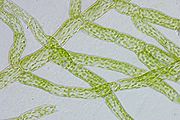
Protonema
Encyclopedia

Bryophyte
Bryophyte is a traditional name used to refer to all embryophytes that do not have true vascular tissue and are therefore called 'non-vascular plants'. Some bryophytes do have specialized tissues for the transport of water; however since these do not contain lignin, they are not considered to be...
life cycle. When a moss
Moss
Mosses are small, soft plants that are typically 1–10 cm tall, though some species are much larger. They commonly grow close together in clumps or mats in damp or shady locations. They do not have flowers or seeds, and their simple leaves cover the thin wiry stems...
first grows from the spore
Spore
In biology, a spore is a reproductive structure that is adapted for dispersal and surviving for extended periods of time in unfavorable conditions. Spores form part of the life cycles of many bacteria, plants, algae, fungi and some protozoa. According to scientist Dr...
, it grows as a protonema which develops into a leafy gametophore
Gametophore
The word gametophore, also known as gametangiophore, is composed of gametangium and "phore" . In moss and fern the gametophore is the bearer of the sex organs , the female archegonia and the male antheridia. If the archegonia as well as the antheridia are arranged at the same plant, they are...
.
Liverworts
Marchantiophyta
The Marchantiophyta are a division of bryophyte plants commonly referred to as hepatics or liverworts. Like other bryophytes, they have a gametophyte-dominant life cycle, in which cells of the plant carry only a single set of genetic information....
do not have a protonemal stage, the spores germinate
Germination
Germination is the process in which a plant or fungus emerges from a seed or spore, respectively, and begins growth. The most common example of germination is the sprouting of a seedling from a seed of an angiosperm or gymnosperm. However the growth of a sporeling from a spore, for example the...
directly into a new Gametophyte generation.
Moss
Moss
Mosses are small, soft plants that are typically 1–10 cm tall, though some species are much larger. They commonly grow close together in clumps or mats in damp or shady locations. They do not have flowers or seeds, and their simple leaves cover the thin wiry stems...
spores germinate
Germination
Germination is the process in which a plant or fungus emerges from a seed or spore, respectively, and begins growth. The most common example of germination is the sprouting of a seedling from a seed of an angiosperm or gymnosperm. However the growth of a sporeling from a spore, for example the...
to form an alga-like filamentous structure called the protonema. It represents the juvenile gametophyte
Gametophyte
A gametophyte is the haploid, multicellular phase of plants and algae that undergo alternation of generations, with each of its cells containing only a single set of chromosomes....
. While the protonema is growing by apical cell division, at some stage, under the influence of the phytohormone cytokinin
Cytokinin
Cytokinins are a class of plant growth substances that promote cell division, or cytokinesis, in plant roots and shoots. They are involved primarily in cell growth and differentiation, but also affect apical dominance, axillary bud growth, and leaf senescence...
, bud
Bud
In botany, a bud is an undeveloped or embryonic shoot and normally occurs in the axil of a leaf or at the tip of the stem. Once formed, a bud may remain for some time in a dormant condition, or it may form a shoot immediately. Buds may be specialized to develop flowers or short shoots, or may have...
s are induced which grow by three-faced apical cells. These give rise to gametophore
Gametophore
The word gametophore, also known as gametangiophore, is composed of gametangium and "phore" . In moss and fern the gametophore is the bearer of the sex organs , the female archegonia and the male antheridia. If the archegonia as well as the antheridia are arranged at the same plant, they are...
s, stems and leaf like structures (bryophytes do not have true leaves (megaphyll)). These gametophores are the adult form of the
gametophyte. Protonema are characteristic of all mosses and some liverworts but are absent from hornwort
Hornwort
Hornworts are a group of bryophytes, or non-vascular plants, comprising the division Anthocerotophyta. The common name refers to the elongated horn-like structure, which is the sporophyte. The flattened, green plant body of a hornwort is the gametophyte plant.Hornworts may be found worldwide,...
s.
The protonema is also the photosynthetic part of a germinating fern
Fern
A fern is any one of a group of about 12,000 species of plants belonging to the botanical group known as Pteridophyta. Unlike mosses, they have xylem and phloem . They have stems, leaves, and roots like other vascular plants...
spore.

